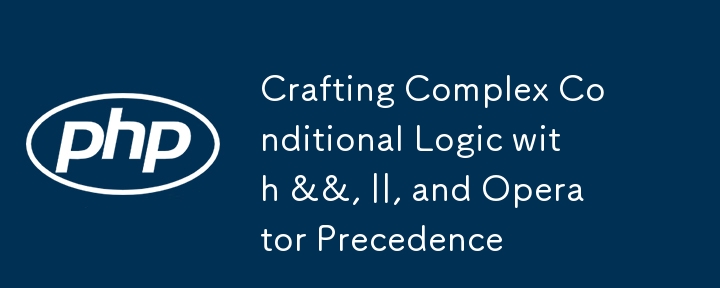 Backend Development
Backend Development
 PHP Tutorial
PHP Tutorial
 Crafting Complex Conditional Logic with &&, ||, and Operator Precedence
Crafting Complex Conditional Logic with &&, ||, and Operator Precedence
Crafting Complex Conditional Logic with &&, ||, and Operator Precedence
Jul 30, 2025 am 04:48 AMWhen using && and || to build complex conditions, operator priority and short-circuit behavior must be clarified; 1. && priority is higher than ||, so a || b && c is equivalent to a || (b && c); 2. Use brackets to clarify logical groups. If you need to "loggedIn or have permission and non-visitors" should be written as (loggedIn || hasPermission) && !isGuest; 3. Split complex conditions into descriptive variables to improve readability; 4. Test boundary conditions to avoid relying on intuitive judgment; ultimately, clarity should be used as the goal to ensure that the code logic is easy to understand and maintain.

When working with programming languages like JavaScript, C, Java, or C , you'll often need to evaluate multiple conditions using logical operators. The two most common are && (logical AND) and || (logical OR). While they seem simple at first, combining them effectively—especially when operator precedence comes into play—can be tricky. Let's break down how to craft complex conditional logic correctly and avoid common pitfalls.

Understanding && and || in Practice
These operators don't always return true or false —they return the value of the last evaluated operator. This behavior is key to understanding how they work in complex expressions.
-
&&returns the first false value, or the last value if all are truthy. -
||returns the first truthy value, or the last value if all are false.
console.log(5 && 'hello' && 0); // 0 (first falsy) console.log(5 && 'hello' && 'world'); // 'world' (all truthy, returns last) console.log(null || 'default'); // 'default' (first truthy) console.log(0 || false || ''); // '' (all falsy, returns last)
This short-circuit behavior means evaluation stops as soon as the result is determined.

Operator Precedence: Why Order Matters
One of the most common sources of bugs in complex conditions is misunderstanding operator precedence .
In most C-style languages:

-
&&has higher precedence than|| - This means
a || b && cis interpreted asa || (b && c), not(a || b) && c
Example: Precedence in Action
const user = { loggedIn: false, hasPermission: true, isGuest: true };
// What does this evaluate?
if (user.loggedIn || user.hasPermission && !user.isGuest) {
console.log("Access granted");
}Let's break it down:
-
user.hasPermission && !user.isGuest→true && false→false -
user.loggedIn || false→false || false→false
So access is denied —but maybe not for the reason you'd expect.
If you intended the condition to mean “grant access if the user is logged in OR has permission, as long as they're not a guest,” you'd need parentses:
if ((user.loggedIn || user.hasPermission) && !user.isGuest) {
console.log("Access granted");
}Now:
-
(false || true)→true -
true && !true→true && false→false(still denied, but logic is clearer)
Wait—still denied? Because isGuest is true , so !user.isGuest is false . That might be correct depending on your rules, but the point is: without parentses, your logic can be silently misinterpreted .
Best Practices for Writing Clear Complex Conditions
To avoid bugs and make your code readable:
- ? Use parentses liberally to clarify intent, even when not strictly needed.
- ? Break complex conditions into variables with descriptive names.
- ? Test edge cases —especially when mixing
&&and||.
Refactored for Clarity
const isLoggedIn = user.loggedIn;
const hasAccessPermission = user.hasPermission;
const isNotGuest = !user.isGuest;
const canAccess = (isLoggedIn || hasAccessPermission) && isNotGuest;
if (canAccess) {
console.log("Access granted");
}Now the logic is self-documenting and much easier to debug.
Common Pitfalls to Avoid
- ? Assuming
||and&&have equal precedence - ? Writing deeply nested conditions without breaking them down
- ? Relying on mental evaluation instead of testing or using parentshes
Even experienced developers get tripped up by precedence. Don't assume— make the order explicit .
Basically, when crafting complex logic with && , || , and operator precedence, clarity beats cleverness. Use parentshes to enforce your intended flow, and name intermediate conditions to make your code readable. It's not just about getting it to work—it's about making sure the next person (or future you) understands why it works.
The above is the detailed content of Crafting Complex Conditional Logic with &&, ||, and Operator Precedence. For more information, please follow other related articles on the PHP Chinese website!

Hot AI Tools

Undress AI Tool
Undress images for free

Undresser.AI Undress
AI-powered app for creating realistic nude photos

AI Clothes Remover
Online AI tool for removing clothes from photos.

Clothoff.io
AI clothes remover

Video Face Swap
Swap faces in any video effortlessly with our completely free AI face swap tool!

Hot Article

Hot Tools

Notepad++7.3.1
Easy-to-use and free code editor

SublimeText3 Chinese version
Chinese version, very easy to use

Zend Studio 13.0.1
Powerful PHP integrated development environment

Dreamweaver CS6
Visual web development tools

SublimeText3 Mac version
God-level code editing software (SublimeText3)

Hot Topics
 Harnessing Short-Circuit Evaluation in PHP's Logical Operators
Jul 29, 2025 am 05:00 AM
Harnessing Short-Circuit Evaluation in PHP's Logical Operators
Jul 29, 2025 am 05:00 AM
Short circuit evaluation is an important feature of logic operators in PHP, which can improve performance and avoid errors. 1. When using &&, if the left operand is false, the right operand will no longer be evaluated; 2. When using ||, if the left operand is true, the right operand will be skipped; 3. It can be used to safely call object methods, such as if($user&&$user->hasPermission('edit')) to avoid empty object calls; 4. It can optimize performance, such as skipping expensive function calls; 5. It can provide default values, but please note that || is sensitive to falsy values, and you can use the ?? operator instead; 6. Avoid placing side effects on the right side that may be skipped to ensure that key operations are not short-circuited. just
 Mastering Strict vs. Loose Comparisons in PHP Conditionals
Jul 29, 2025 am 03:05 AM
Mastering Strict vs. Loose Comparisons in PHP Conditionals
Jul 29, 2025 am 03:05 AM
Using == for strict comparison will check the value and type at the same time, and == will perform type conversion before comparing the value; therefore 0=='hello' is true (because 'hello' is converted to an integer is 0), but 0==='hello' is false (different types); common traps include '0'==false, 1=='1abc', null==0 and []==false are all true; it is recommended to use === by default, especially when processing function return value (such as strpos), input verification (such as the third parameter of in_array is true), and state judgment to avoid unexpected results caused by type conversion; == is only used when it is clearly necessary to use ==, otherwise
 Secure by Design: Using if Statements for Robust Input Validation
Jul 30, 2025 am 05:40 AM
Secure by Design: Using if Statements for Robust Input Validation
Jul 30, 2025 am 05:40 AM
InputvalidationusingifstatementsisafundamentalpracticeinSecurebyDesignsoftwaredevelopment.2.Validatingearlyandoftenwithifstatementsrejectsuntrustedormalformeddataatentrypoints,reducingattacksurfaceandpreventinginjectionattacks,bufferoverflows,andunau
 Implementing Dynamic Feature Flags with Elegant Conditional Logic
Jul 29, 2025 am 03:44 AM
Implementing Dynamic Feature Flags with Elegant Conditional Logic
Jul 29, 2025 am 03:44 AM
Maintainable implementations of dynamic functional flags rely on structured, reusable, and context-aware logic. 1. Structural definition of function flags as first-class citizens, centrally manage and accompany metadata and activation conditions; 2. Dynamic evaluation is performed based on runtime context (such as user roles, environments, grayscale ratios) to improve flexibility; 3. Abstract reusable condition judgment functions, such as roles, environments, tenant matching and grayscale release, avoiding duplicate logic; 4. Optionally load flag configurations from external storage, supporting no restart changes; 5. Decouple flag checks from business logic through encapsulation or hooks to keep the code clear. Ultimately achieve the goals of secure release, clear code, fast experimentation and flexible runtime control.
 Improving Code Readability with Guard Clauses and Early Returns
Jul 29, 2025 am 03:55 AM
Improving Code Readability with Guard Clauses and Early Returns
Jul 29, 2025 am 03:55 AM
Using guard clauses and early return can significantly improve code readability and maintainability. 1. The guard clause is a conditional judgment to check invalid input or boundary conditions at the beginning of the function, and quickly exit through early return. 2. They reduce nesting levels, flatten and linearize the code, and avoid the "pyramid bad luck". 3. Advantages include: reducing nesting depth, expressing intentions clearly, reducing else branches, and facilitating testing. 4. Commonly used in scenarios such as input verification, null value check, permission control, and empty collection processing. 5. The best practice is to arrange the checks in order from basic to specific, focusing on the function start part. 6. Avoid overuse in long functions causing process confusion or causing resource leakage in languages that require resource cleaning. 7. The core principle is: check as soon as possible and return as soon as possible
 Refactoring the Pyramid of Doom: Strategies for Cleaner PHP if Blocks
Jul 29, 2025 am 04:54 AM
Refactoring the Pyramid of Doom: Strategies for Cleaner PHP if Blocks
Jul 29, 2025 am 04:54 AM
Useearlyreturnstohandlepreconditionsandeliminatedeepnestingbyexitingfastonfailurecases.2.Validateallconditionsupfrontusingadedicatedhelpermethodtokeepthemainlogiccleanandtestable.3.Centralizevalidationwithexceptionsandtry/catchblockstomaintainaflat,l
 Performance Deep Dive: if-elseif-else vs. switch in Modern PHP
Jul 29, 2025 am 03:01 AM
Performance Deep Dive: if-elseif-else vs. switch in Modern PHP
Jul 29, 2025 am 03:01 AM
Switch is usually faster than if-elseif-else, especially when there are more than 5 discrete values and PHP can be optimized to skip tables; 2. If-elseif is more suitable for complex or range condition judgments; 3. The performance of the two is similar when a small number of conditions (1–3); 4. Turn on Opcache to improve the optimization opportunities of switches; 5. Code readability is preferred, and it is recommended to use PHP8.0 match expressions in simple mapping scenarios because they are simpler and have better performance.
 Yoda Conditions in PHP: A Relic of the Past or a Valid Defensive Tactic?
Jul 30, 2025 am 05:27 AM
Yoda Conditions in PHP: A Relic of the Past or a Valid Defensive Tactic?
Jul 30, 2025 am 05:27 AM
Yodaconditionsaremostlyarelicofthepast,butstillhavelimitedvalidityinspecificcontexts;theyoriginatedtopreventaccidentalassignmentbugs,suchasif($answer=42),byreversingtheordertoif(42===$answer),whichcausesafatalerrorif=ismistakenlyused;however,modernPH





